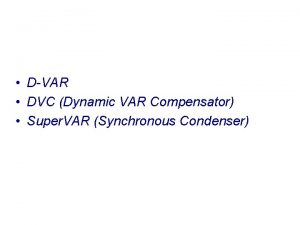THE NEW STATIC VAR COMPENSATOR FOR SPS COMMISSIONING

- Slides: 1

THE NEW STATIC VAR COMPENSATOR FOR SPS – COMMISSIONING RESULTS based on the CIRED 2003 conference paper from K. Kahle, J. Pedersen (CERN) and T. Larsson, M. M. Oliveira (ABB) CERN - European Organization for Nuclear Research K. Kahle Background Design The SPS electrical network currently consists of: • 3 transformers 400/18 k. V • 3 Static Var Compensators (1974, 1976 and 2002) • 2 main groups of SPS power converters The new Static Var Compensator (SVC) was required: • to have a third redundant supply group (3 transformers and 3 SVC’s) • to facilitate the renovation of the two existing Static Var Compensators • to cover the load increase due to the LHC injection tunnels TI 2 / TI 8. SPS Existing SVC BEQ 1 New SVC BEQ 2 Existing SVC BEQ 3 Simplified layout of the SPS electrical network Purpose of the Static Var Compensator (SVC): The electrical current in the SPS magnet is pulsating between zero Ampere and 4500 Ampere every 14 seconds. A Static Var Compensator: • compensates for the reactive power • stabilizes the 18 k. V voltage (variation: 14% without SVC, 0. 75 % with SVC) • eliminates the harmonics created by the pulsating load (harmonic distortion: 20% without SVC, 0. 74 % with SVC) Calculations Measurements after installation before installation Results of 18 k. V harmonic calculations: The measurements correspond closely to the calculated values. Calculated harmonics performance Results of 18 k. V voltage measurements: Small variations of the 18 k. V voltage were expected at the transition points from the rising slope of the power pulse to the flat top and from the flat top to the pulse descent. Measured 18 k. V bus voltage The voltage response was recorded and the data post-processed with MATLAB. The comparison of the calculated 18 k. V voltage with the measured response shows large similarities. All voltage notches, both up and down, are identical. Only the first notch at t=9 s of the measurement is critical, while the second, larger variation at t=10. 5 s has no major significance for the physics performance of the SPS accelerator. Some discrepancies were found in the amplitude of the notches, where the measurements show larger voltage variations than the calculations predicted. Here the computer model needs to be improved in the future. Computer calculations: a) active and reactive power b) resulting 18 k. V voltage c) TCR susceptance reference d) TCR firing angle e) reactive power from 400 k. V network Conclusions Measured harmonic performance The EMTDC computer simulations modeled the behavior of the SPS power converters, of the Static Var Compensator and of the interaction between them. The main purpose of the Static Var Compensator is to stabilize the 18 k. V voltage, therefore the resulting 18 k. V network voltage was calculated for a complete SPS pulse. April 2003 Layout of the SVC The SVC consists of a TCR rated at 150 Mvar and eight harmonic filters tuned to 100, 150, 250, 350, 550, 650 Hz and two damped high-pass filters. The filters generate a total reactive power of 130 Mvar. Total Harmonic Distortion 0. 74 % no individual harmonic exceeding 0. 5 % The studies confirmed that eight harmonic filters were needed to achieve the required excellent performance. Impedance diagram The SVC is an outdoor installation covering an area of about 2500 m 2. It also includes a prefabricated building for the high voltage thyristor valves, the cooling system and the SVC control system. The remaining space is used for the harmonic filters. Results of 18 k. V harmonic measurements: Total Harmonic Distortion < 0. 8 % no individual harmonic exceeding 0. 35 % Results of 18 k. V voltage calculations: The new Static Var Compensator for the SPS, CERN Prevessin Following a long history of SVC projects at CERN since 1974, the new 150 Mvar 18 k. V Static Var Compensator was successfully installed and tested in 2002. During the project there was a unique opportunity to compare and verify comprehensive computer studies with the results of extensive measurements. Following the actual performance tests, the correct operation of the SVC, together with the SPS accelerator, was successfully proven over a period of several months. This project also shows the excellent SVC performance, which can be achieved for fast changing rectifier loads, by using conventional TCR technology, combined with passive filtering. Measured load current during a SPS pulse 6 th ST Workshop, THOIRY

